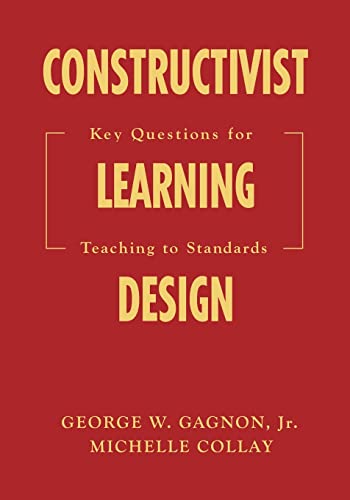
Synopsis
"Very practical and user-friendly . . ."
--Linda R. Kroll, Professor
Department of Education, Mills College
Build student-centered learning into your standards-based curriculum and lesson plans!
Educators expect learners to solve problems, think critically, communicate effectively, and collaborate well. These complex processes require young learners to engage in active learning and to understand that their own experience is the foundation for new learning. They also require teachers to move from the traditional role of "sage on the stage" to the new role of "guide on the side."
Constructivist Learning Design offers teachers a six-step framework for lesson planning and assessment:
- Situation: develop goals, tasks, and curriculum standards
- Grouping: group students and materials, and use cooperative learning
- Bridge: recall prior knowledge using students′ cognitive maps, skills, values, motivation, and expectations
- Task: use higher-level thinking skills and problem-based learning
- Exhibit: arrange student portfolios and work samples
- Reflection: synthesize critical thinking and knowledge
With clear classroom applications and ready-to-use planning templates, this research-based resource guides teachers through the complex process of aligning constructivist learning events with standards-based curriculum. Engage students in tasks, help them think for themselves, and support them in making meaning of their learning!
"synopsis" may belong to another edition of this title.
About the Authors
George W. Gagnon, Jr. is the Director of K-12 Partnerships in the College of Engineering at the University of California, Berkeley. He works with teacher and parent partners to support students who would be the first generation in their family to be engineers or scientists. George uses Math Models he has designed to support students in developing a conceptual understanding of mathematics. George has studied learning for thirty years as a teacher, principal, and teacher educator. Now he applies his research on constructivist learning design, appropriate assessment, and learning communities to encourage educational equity in urban public schools. George and Michelle live in Oakland, California, and are actively involved with the neighborhood public schools their children attend.
Michelle Collay is a School Coach for the Bay Area Coalition for Equitable Schools (BayCES) in Oakland, California, a private non-profit organization supporting urban small school initiatives. She supports school leader development and coordinates classroom-based teacher inquiry for the purposes of improving student achievement. Previously, she worked as a faculty member and administrator in teacher preparation and graduate teacher education in public and private universities. Collay conducts seminars and workshops about professional learning communities, constructivist learning design, and portfolio development. Before completing doctoral studies in Curriculum and Instruction at the University of Oregon, she taught music and mathematics in elementary and junior high school and continues to play the bassoon in local ensembles. She and her husband, George Gagnon, write, teach, and parent together and are parent leaders in their children’s neighborhood school in Oakland.
"About this title" may belong to another edition of this title.
Other Popular Editions of the Same Title
Search results for Constructivist Learning Design: Key Questions for Teaching...
Constructivist Learning Design : Key Questions for Teaching to Standards
Seller: GreatBookPrices, Columbia, MD, U.S.A.
Condition: As New. Unread book in perfect condition. Seller Inventory # 3512663
Constructivist Learning Design: Key Questions for Teaching to Standards
Seller: Ria Christie Collections, Uxbridge, United Kingdom
Condition: New. In. Seller Inventory # ria9781412909556_new
Buy New
Quantity: Over 20 available
Constructivist Learning Design: Key Questions for Teaching to Standards
Seller: Lucky's Textbooks, Dallas, TX, U.S.A.
Condition: New. Seller Inventory # ABLIING23Mar2411530182513
Constructivist Learning Design : Key Questions for Teaching to Standards
Seller: GreatBookPrices, Columbia, MD, U.S.A.
Condition: New. Seller Inventory # 3512663-n
Constructivist Learning Design : Key Questions for Teaching to Standards
Seller: GreatBookPricesUK, Woodford Green, United Kingdom
Condition: New. Seller Inventory # 3512663-n
Buy New
Quantity: Over 20 available
Constructivist Learning Design: Key Questions for Teaching to Standards
Seller: Chiron Media, Wallingford, United Kingdom
PF. Condition: New. Seller Inventory # 6666-IUK-9781412909556
Buy New
Quantity: 10 available
Constructivist Learning Design : Key Questions for Teaching to Standards
Seller: GreatBookPricesUK, Woodford Green, United Kingdom
Condition: As New. Unread book in perfect condition. Seller Inventory # 3512663
Buy Used
Quantity: Over 20 available
Constructivist Learning Design: Key Questions for Teaching to Standards
Print on DemandSeller: THE SAINT BOOKSTORE, Southport, United Kingdom
Hardback. Condition: New. This item is printed on demand. New copy - Usually dispatched within 5-9 working days 481. Seller Inventory # C9781412909556
Buy New
Quantity: Over 20 available
Constructivist Learning Design: Key Questions for Teaching to Standards
Print on DemandSeller: moluna, Greven, Germany
Condition: New. Dieser Artikel ist ein Print on Demand Artikel und wird nach Ihrer Bestellung fuer Sie gedruckt. Use the Constructivist Learning Design (CLD) six-step planning framework to engage students in constructivist learning events that meet standards-based outcomes.Über den AutorGeorge W. Gagnon, Jr. is the Directo. Seller Inventory # 595740315
Constructivist Learning Design | Key Questions for Teaching to Standards
Print on DemandSeller: preigu, Osnabrück, Germany
Taschenbuch. Condition: Neu. Constructivist Learning Design | Key Questions for Teaching to Standards | George W. Jr. Gagnon (u. a.) | Taschenbuch | Kartoniert / Broschiert | Englisch | 2006 | Corwin | EAN 9781412909556 | Verantwortliche Person für die EU: Libri GmbH, Europaallee 1, 36244 Bad Hersfeld, gpsr[at]libri[dot]de | Anbieter: preigu Print on Demand. Seller Inventory # 102301569

